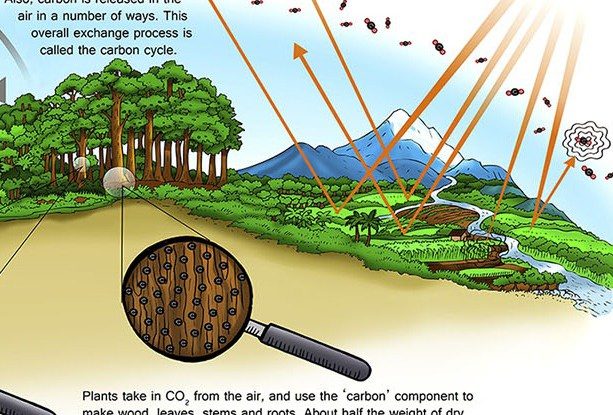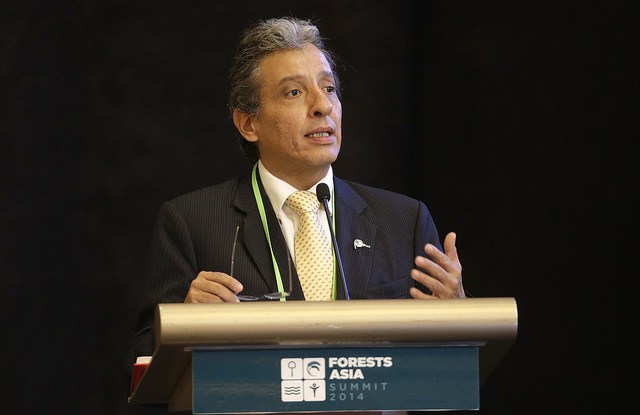BOGOR, Indonesia—It’s expected to be a major topic at the UN climate talks in Lima: how to ensure that climate change mitigation projects in tropical forests safeguard the rights and priorities of local communities where these projects take place.
This includes making local people active participants in efforts to monitor and report the carbon stocks held in their forests.
There’s one small problem: For a rural forest-dweller, it is difficult to help measure carbon if you don’t understand what it actually is, or how it affects you.
This was a perennial problem for scientists trying to conduct such research in tropical forest communities in Indonesia related to the REDD+ initiative (Reducing Emissions from Deforestation and forest Degradation).
The program seeks among other things to provide financial incentives to avert carbon emissions through avoided deforestation.
“When we go to the field and we want to present our work to villagers and local government staff, we don’t want to lie and say, ‘Oh, it’s about forest management,’ ” said Manuel Boissière, a scientist with the Center for International Forestry Research (CIFOR) and the Agricultural Research Center for International Development (CIRAD). “No, we’re talking about REDD+ and we’re talking about carbon, so we have to be clear about it.”
Boissière leads CIFOR’s Participatory Monitoring, Reporting and Verification (PMRV) project, which investigates under what conditions forest communities could participate in climate mitigation initiatives by providing inputs and taking part in decision-making related to land management. Fieldwork for the project required intensive communication between the scientists and the local communities.
Often they say, ‘Look, before we tell you yes or no, we want to know more about what this carbon thing is.’
“When we went to Papua [to do fieldwork], every time we entered a village, we explained our study during community meetings,” Boissière said. “So that they know what we are doing. We then asked for authorization from local people to conduct our research, and it’s up to them to say yes or no.”
There was a common refrain at these meetings, he said.
“Often they say, ‘Look, before we tell you yes or no, we want to know more about what this carbon thing is.’ ”
The same happened at meetings in the other project sites, in Java and in Kalimantan, as villagers consistently asked: “What is carbon?”
WHAT CARBON IS
Boissière and his team had to figure out how to explain this in a simple way.
It’s harder than it sounds. The carbon cycle, its relationship to forests, and its impact on climate change is a long, complex issue that is not easily explicable to different stakeholders (including rural communities) with different levels of education—and different ways of thinking about the environment.
To fill this gap, Boissière and his team gave short trainings and distributed books to help explain the science, but it was not enough. The team hit upon the idea of showing a poster—a quick and simple way to convey a lot of information to a room full of people all at once.
So the team set out to make their own, enlisting climate experts at CIFOR and a graphic designer to ground it in science but also make it simple to understand and visually attractive.
The result: A poster that asks—and seeks to answer—“What is carbon? Why should we be worried?”
Still, the poster is only a first draft, Boissière says.
“Right now it’s in English—we will translate it to Indonesian and will test it with local NGOs who are working with local communities directly,” he said. “Next time researchers are going to the field, we can give them a printout of the poster and ask them to explain it to villagers and see what their response is, so we can improve the current version.”
Indeed, his team is seeking feedback and suggestions about the posted on CIFOR’s PMRV website: cifor.org/pmrv.
It’s not only rural people who could learn from this poster, he said—local government, students, and scientists who are unfamiliar with carbon and climate change could benefit.
Boissière hopes the poster will live on as a tool for CIFOR and for other organizations, especially with greater attention to the social aspects of REDD+.
For more information about the topics of this research, please contact Manuel Boissiere at m.boissiere@cgiar.org.
CIFOR’s PMRV project is in collaboration with CIRAD, is funded in part by USAID and Norad, and forms part of the CGIAR Research Program on Forests, Trees and Agroforestry.
We want you to share Forests News content, which is licensed under Creative Commons Attribution-NonCommercial-ShareAlike 4.0 International (CC BY-NC-SA 4.0). This means you are free to redistribute our material for non-commercial purposes. All we ask is that you give Forests News appropriate credit and link to the original Forests News content, indicate if changes were made, and distribute your contributions under the same Creative Commons license. You must notify Forests News if you repost, reprint or reuse our materials by contacting forestsnews@cifor-icraf.org.


